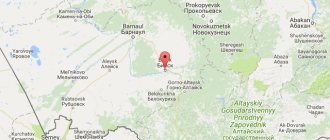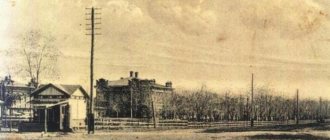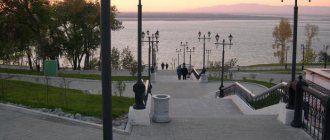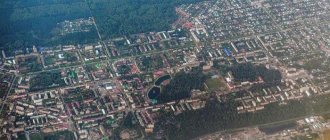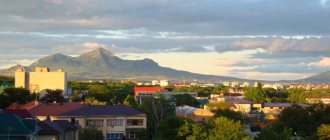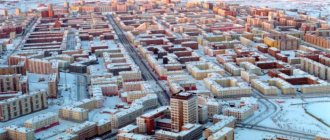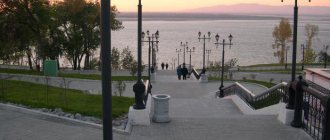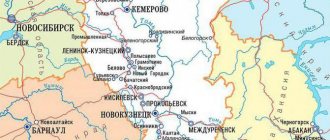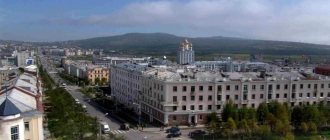Save it for yourselfPrint
The city of Essentuki is located in a special ecological resort zone - Caucasian Mineral Waters. Essentuki became famous due to its mild continental climate and mineral water with unique healing properties. The town is small, cozy, a lot of greenery. It’s not the capital, of course, but all the necessary infrastructure is there and functions all year round, because people come here from different parts of the country and even the world, all year round.
The population of Essentuki is just over 100 thousand people. Territory: 50 km². Moscow time.
The name Essentuki is associated with the name of a local feudal lord, who was even a descendant of Genghis Khan. His name was Essen. The name of the place passed on to the Cossacks who stood patrol here, and then it came down to the present day. The name of the city is well known even to those who have no idea where it is. The reason for this is the bottles with the inscription “Essentuki-17” and “Essentuki-4” on store shelves, which are familiar to residents throughout Russia.
Mineralnye Vody is 43 km from Essentuki and 17 km to the city of Pyatigorsk. Height above sea level 640 meters. Located in the steppe area, in the valley of the Podkumok River.
A resort area has been designated in Essentuki. It is located south of the railway line, so there is no need to cross or under the tracks, as in Adler. The area of the resort area is about 7% of the total area of the city.
General information and history of the city
Russia is a country rich in all kinds of holidays, sometimes lasting for weeks. But the result of such endless feasts can be stomach problems, and for some, even worse: a terrible hangover. Well, who hasn’t gotten rid of these ailments with mineral water “Essentuki-17” and “Essentuki-4”?
So, for those who don’t know, Essentuki is not just water, but a resort city in the south of our country, a quiet and cozy corner of the Caucasian Mineral Waters. Back in the 19th century, a Volga Cossack detachment came across unpleasant-smelling and salty-tasting springs in this area in a swampy area near the Kislusha stream. The Cossacks did not drink from the springs, but their horses could not be pulled away from this water. This is how the main means of modern Essentuki treatment were discovered - mineral springs and healing mud.
Essentuki is located in the southern part of the Stavropol Territory, on a flat foothill on the northern slopes of the Caucasus Range. The area of the city is approximately 50 km2 and is located along the Podkumok River.
Climate and ecology of Essentuki
The geographical location of Essentuki determines the climate of this city - here it is continental, mountain-steppe, characterized by a pronounced seasonal contrast, that is, the summer here is hot and dry, the winter is cool and snowy, the autumn is foggy, and the spring is warm, but very short, just over a month.
In the spa healing park
Since there are no enterprises in Essentuki that pollute the air with their waste, it is a fairly clean city from an environmental point of view.
Why pay more? Popular Internet meme on the topic of flooding in Essentuki
And yet, problems did not escape this resort. Firstly, the mountains located near the city are not only beautiful, but also radioactive contamination coming from some rocks. Secondly, such a scourge of modern cities as car exhaust fumes. Thirdly, pollution of nearby water bodies through the discharge of untreated wastewater. Fourthly, spontaneous and illegal landfills within the city and its immediate surroundings. And finally, fifthly, littering the city by the citizens themselves.
Sights of Essentuki
Guests consider the most famous sights of Essentuki to be:
- Essentuki Museum of History and Local Lore named after. V. P. Shpakovsky. Opened in 1963. Located in an old mansion that once belonged to the priest D. Ya. Karagachev. The museum's collections are full of stunning exhibits. Among them are elements of building materials from mausoleums from the times of the Golden Horde and furniture from the 18th century with bone inlay.
- Mud bath named after N. A. Semashko. She has an interesting story. In 1911, a competition for architects was announced in St. Petersburg. Conditions: come up with the most interesting project for the Essentuki mud baths. Architect Evgeniy Shretter was inspired by ancient motifs; his design for a building in ancient neoclassicism turned out to be the best. At the main entrance of the mud baths sit stone Asclepius and Hygeia - the god of healing and the goddess of purity and health, father and daughter.
An interesting fact is the walls of the mud bath named after N.A. Semashko exterior is lined with dolomite from the Alikonovsky Gorge in Kislovodsk
- Resort healing park. In 1874, by order of Prince Vorontsov, tree planting began in front of the gallery of source No. 17. And already in 1901, F.I. performed in the theater built there. Chaliapin and played in the performances of V.F. Komissarzhevskaya. The park has many attractions: a rotunda colonnade, an Oreanda gazebo, drinking pump rooms in an antique style
- Tsanderovsky Mechanotherapeutic Institute. The institute building was built in 1902. The place was swampy, so the foundation of the building was made of stone. The architecture of the mechanotherapy hall has no analogues in Russia.
- Fountain in the central square. This fountain is the largest in the south of Russia. Its area is more than 400 square meters. It does not have a bowl, so it is not visible when turned off. Literally every minute the fountain throws 10 tons of water into the air. This is one of the most popular places in the city
All attractions>
City population
The population of the city of Essentuki has exceeded 100 thousand people. Most of the population are people of working age, a smaller part are pensioners and a very small part are those who are under 16 years old. If you don’t delve too deeply into the calculations, the approximate figures are as follows: 60% in the first group, 24% in the second and 16% in the third.
For various reasons, people who come from other cities and even states become Essentu residents; for example, in 2013 there were almost 2.5 thousand people.
Essentuki is home to a predominantly Russian population – about 80 thousand people. Other nationalities are represented by Greeks, more than 10 thousand, and Armenians, more than 8 thousand. Also on the territory of the resort city there are Ukrainians, Azerbaijanis, Georgians, Ossetians, Karachais, Kabardins, peoples from Dagestan, and it is worth mentioning the Cossacks.
People in Essentuki, as befits normal resort residents, are polite, cultured, friendly and responsive. Locals understand perfectly well that it is thanks to tourists that the city lives and develops. Therefore, a lost guest will not have to worry - help will always be provided here and directions will be given. Well, this again, if you meet a normal resident of the resort. It also happens that after talking with some aborigine, who is indifferent at best, you get the feeling that you were not expected here, but that you were right in there.
Districts and real estate of Essentuki
Although there are no official administrative districts in Essentuki, the city is still divided into microdistricts. They are called simply: Microdistrict 1, Microdistrict 2, Microdistrict 3, Microdistrict 4, as well as Severny, Opytnik, Beshtaugorets, Zapolotnyanka, Drop beam. The schematic map of Essentuki looks like this.
Essentuki Map
Historically, urban development in Essentuki is located on the left bank of the Podkumok River and stretches for 13 kilometers along it. And, as practice shows, even a small territory of a settlement requires geographical separation for the convenience of life. So these Essentuki kilometers were also divided. There are microdistricts here with numbers: No. 1, No. 2, No. 3, No. 4 - they received their names in order of construction in the 60s. last century.
2 microdistrict
In Microdistrict No. 3, the districts Fantasia and Veteran are distinguished, or even these names are simply used as synonyms. Severny is a district located in the northern part of Essentuki. Microdistrict Opytnik, they say that in the post-war period there was an experimental farm for growing seedlings. The Beshtaugorets area offers a good view of Beshtau, perhaps hence the name.
Beshtaugorets
Zapolotnyanka is located behind the railway track, which runs through the city center.
Drop beam is an area located in the northeast of the city; There is a large ravine with an active watercourse here. In addition to these areas, local residents name more than a dozen more districts. The most famous are White Coal (the first hydroelectric power station in Russia appeared here, which began to be called White Coal); Green (once there was a market here where only greens were sold: fruits, vegetables, flowers); Resort area (an area that includes parks, drinking galleries, sanatoriums, mud baths);
Resort (adjacent to the resort area with residential buildings); Pribrezhny (territory occupied by the construction of houses for flood victims in 2002); Stroitel (the area where there used to be a sports complex for builders, and today the Stroitel hotel). Well, if you are dividing to the point of fanaticism, then in Essentuki there are still the districts Brick, the Victoria sanatorium, Aquawhite, Aerodrome, Upper Market, Railway Station, Infectious Diseases Hospital, Furniture Factory, Medical School, Mill, Lower Market, Lake, Glass, School No. 5, school No. 9, Teleatelier, Yuzhny and others.
If we talk about the most developed areas, then these are Microdistrict No. 3 (“Fantasy”, “Veteran”), “Resort” and “Resort Zone”, located in the center. It’s best to live in “Fantasy”; it has kindergartens, schools, shops, a swimming pool, a market, a nightclub, a cinema, as well as the tax office and Sberbank; nearby are a maternity hospital, a city hospital and an ambulance station.
Fantasy
In addition, from here you can get to any part of the city by public transport without transfers. In the center of the city, divided by a railway, there are sanatorium-resort institutions, two parks: Lechebny and Pobedy, the Spartak stadium, quarters of historical Cossack buildings, station square, and administrative buildings. Such historically established residential formations as White Coal, Kapelnaya Balka, Zapolotnyansky (Zapolotnyanka), Yuzhny, Severny, Zolotushka are geographically separated, which has a negative impact on transport links between these areas and the scope of their services.
In Essentuki, until recently, the predominant housing was private households, but now many new buildings have appeared, especially in Microdistrict No. 4, Kapelnaya Balka, a small section of Microdistrict No. 3. But, of course, there are also many dilapidated estates, in particular in Microdistrict No. 2. For those interested to buy new housing in Essentuki, you will have to spend money on repairs, since most of it is rented, as they say, with bare walls.
You can also buy an apartment on the secondary market in a house built 20 or 40 years ago. And it can be either small-sized or housing with an improved layout. Prices for private houses in Essentuki are around 5.5 million rubles, there are, of course, prices for 30 million rubles, and for apartments - an average of 36 thousand per square meter (and they rise almost daily).
Everyone can afford to buy housing in Essentuki. The question is finances and requests - it could be a room in a hostel or an old building in the center with partial amenities, and these homes can be purchased for 500-600 thousand rubles. But you may also like an elite apartment or mansion, and for them you will have to pay 15 million or more. One hundred square meters of land can be bought for 280-300 thousand rubles, and office space costs almost 50 thousand per m2. It is clear that people often come to the resort just to relax, and not for permanent residence, and in this case it is enough to simply rent an apartment. Renting an apartment in Essentuki averages 10.5 thousand rubles per month.
Essentuki
Video: Essentuki
Cki3LqVgJOo
Basic moments
Mud baths in Essentuki
A cozy city with a population of 100,000 inhabitants, included in the list of the most unique resorts in the Russian Federation for its healing and natural factors, has a strict reputation and is practically devoid of flashy pathos characteristic of most such places. People come to Essentuki not for dizzying entertainment and noisy parties, but for medicine for the body and soul, which are, first of all, hydromineral resources, beautiful Caucasian nature, as well as a welcoming atmosphere of peace and modest dignity, which breathes in every corner of the resort.
Fountain opposite Theater Park
City streets
History of Essentuki
The official founding date of the city is 1825, although long before that there were Mongol-Tatar settlements on the site of today’s Essentuki. At the end of the 18th century, a redoubt was built on the left bank of the Bolshoi Essentuchok River, in which the Volga Cossacks settled. It was they who discovered mineral springs located not far from the fortification, near the Kislusha stream. The warriors were never able to properly evaluate the properties of mineral water, so the springs did not arouse interest among scientists for a long time.
At the beginning of the 19th century, Professor A.P. Nelyubin finally got to the springs, examining their properties and describing the chemical composition of 28 springs. However, the first vacationers in these places appeared only in 1835, when baths were built in Essentuki, where local mineral water was served. In 1864, the resort acquired its first hotel, but tourists showed real interest in it only at the beginning of the 20th century with the appearance of specialized sanatoriums and spas in the city. The peak of Essentuki's popularity came in the 20s of the last century, when the provincial place finally received the status of a resort town.
Geography and climate
One of the best balneological resorts in Russia is located at the confluence of the Bugunta and Podkumka rivers, 15 km from Pyatigorsk. Essentuki is characterized by a continental mountain-steppe climate: winters here are not very frosty, so thaws in this part of the Caucasian Mineral Waters are a common occurrence. Spring at the resort is very short, turning into a warm, dry summer with an average July temperature of +27 °C. The autumn months in Essentuki also delight with dry, fine days, despite the fact that the first frosts come to the city already in October.
Resort areas
Essentuki is divided into several dozen microdistricts, some of which are simply numbered instead of names. The medical and health zone with the adjacent Main (Resort) and Komsomolsky parks is located closer to the northern part of the city. By the way, most of Essentuki’s health resorts are clustered in the area of parks (Pobeda and Kurortny). There you can also find the main mineral springs.
Tourists planning to rent housing within the city are better off going to the central part of Essentuki: the Kurortny, Veteran, Fantasia and No. 3 microdistricts. Here the infrastructure is more developed, and sanatoriums are just a stone's throw away. In addition, major public transport routes pass through this part of the city. If desired, overnight accommodation can be found on the outskirts of the city. Considering the fact that taxi services in Essentuki are quite inexpensive, you can ride from the suburbs to the center without much damage to your wallet.
Sanatorium treatment in Essentuki
Doctors in Essentuki mainly treat chronic diseases of the gastrointestinal tract and gall bladder, as well as liver and kidney diseases, diabetes and obesity. Some health resorts also undertake to treat disorders of the musculoskeletal system, as well as “women’s diseases”. Vacationers are given water mainly with local mineral water (“Essentuki 17”, “Essentuki 4”), and they also receive compresses with healing sulfide silt from Lake Tambukan.
In comparison with average European balneological resorts, prices in Essentuki health and wellness centers are quite moderate. For example, for 2000 rubles. per day in the sanatoriums “Victoria”, “im. Pavlova", "Healing Key" you can get not only a quite decent room, but a whole package of useful procedures. There are more impressive options like “Rus”, “Kazakhstan” and “Istochnik”, where a course of treatment with accommodation and meals will cost from 4,000 to 6,000 rubles. per day. Some establishments provide the possibility of moving in with a child (“Source”, “Valley of Narzans”).
Important! You can count on services in local health and treatment complexes only if you have a sanatorium-resort card, which must first be issued at the place of residence of the vacationer. Moreover, this should be done no earlier than 5 days before departure to Essentuki.
Beach holiday
In fact, the only open body of water in Essentuki where you can swim is the Big Lake near the former White Coal hydroelectric station. For the convenience of vacationers, a quite decent beach is equipped here, where the necessary equipment can be rented. For romantic walks along the water surface, you can rent a kayak at the nearest boat station.
If you want something more unusual, you should look at the salt lake Tambukan, where healing sapropel is mined for Kavminvodsk sanatoriums. Holidays on its shores are quite specific, since there are no beaches in the generally known sense, and the smell of the lake does not evoke the most pleasant associations. In addition, the concentration of salt in the reservoir is high, and this feature does not have the best effect on the skin, so if you are serious about swimming in Tambukan, do not be lazy to take a container of fresh water with you.
Entertainment and attractions
Essentuki is one of the youngest and most modest resorts of the Caucasian Mineral Waters. Lermontov never set foot here (although there is a monument to the classic in the city), and local sanatoriums are not spoiled by visits from all kinds of VIPs. As for the city’s attractions, it’s easy to get around them on foot in just 2-2.5 hours.
You can drink mineral water and feed tame squirrels in the Essentuki Resort Park, which was laid out here back in 1848. This green area is quite large, so exploring its paths will take several hours. By the way, don’t forget to take a photo of the site plan located at the entrance - this will make it easier to navigate the route and not get lost in the park alleys. As for the drinking pump rooms, some of them are closed due to the decreased number of visitors. However, you can still taste the famous mineral water here - just find the “Source” drinking gallery, where the city’s main medicine is served cold and heated.
Useful information: you can drink a glass or two of Essentuki at the resort absolutely free. But for the opportunity to get some water in reserve, you will have to pay. The amount is usually symbolic and does not exceed 7-10 rubles. per liter
Among the architectural objects of Essentuki, it is worth paying attention to the mud baths named after. N.A. Semashko, located in the same Resort Park. The monumental complex in the style of ancient neoclassicism is more reminiscent of the country villa of a Roman senator, which is why it often serves as a spectacular backdrop for resort selfies. By the way, the institution, built in 1915, remains operational to this day, so if you suddenly want to try the wonderful effects of Tambukan mud, welcome inside the complex.
Another original pavilion of the park, made in a non-traditional half-timbered style for Russia, is the mechanotherapy building. The place is interesting because before the revolution there was a kind of fitness room here, the special mechanical structures of which, designed by the Swedish doctor G. Zander, were supposed to restore the health and physical activity of vacationers. Some of Zander's legacy has survived to this day, so don't miss the opportunity to look inside the building and work out on the ancestors of modern sports equipment.
If your visit to Essentuki coincides with the summer season, do not pass by the central square of the city, where there is a very unusual fountain. The facility, with an area of approximately 400 m², takes the form of an open area located on the same level as the road surface. Hidden underground pipes every minute spew powerful vertical water jets into the air, causing great delight among children and those who observe such a spectacle for the first time. On particularly hot days, you can meet extreme sports enthusiasts taking cold showers in the fountain.
Excursions to the local hydroelectric power station “White Coal”, famous for the fact that it was built before the revolution, are still popular. Modest by modern standards, the structure has long been the main supplier of energy for four KMS resorts. In 2003, the hydroelectric power station was converted into a museum, where local guides now take tourist groups.
The place to look for traces of the first settlers is on the left bank of the Bolshoi Essentuchka, on the Essen-Tuk hill, where ancient burials were once located. Hidden here are the remains of the mausoleum of the Mongol-Tatar nobleman Essen, who lived on the territory of the modern resort during the heyday of the Golden Horde, and whose name, according to legend, gave the name to the modern city. Later, the so-called “Tomb of the Witch” was discovered in the surrounding area - another ritual burial dating back to the 3rd century AD. The contents of the tomb were quickly taken to museums, so that today almost nothing remains of the grave, like most other ritual mounds.
You can find out some interesting facts from the resort’s past at the local history museum on Kislovodskaya Street. The spacious exhibition halls contain fragments of the Essen mausoleum, as well as other exhibits, among which pride of place belongs to an 18th-century furniture set by an unknown master.
On Pushkin Street, on the territory of the Victoria boarding house, there is the main pride of Essentuki - the Five Thousand Gallery. This is the largest drinking pavilion in Europe, capable of accommodating 5,000 visitors at a time. The building has the shape of a closed circle and is famous among vacationers for the fact that you can try three types of Narzan there. True, the gallery does not have its own wells, so water is simply brought here from nearby sources.
Zimin’s dacha or “Eagle’s Nest” also has no shortage of visitors. The elegant mansion with turrets and balconies was built by police officer I.G. Zimin in 1912 for his personal needs. With the advent of Soviet power, the small palace was nationalized and converted into a hospital. Today, the former bailiff's apartment houses the city library.
Transport
Public transport in Essentuki includes minibuses and taxis. The first ones ply the streets from 6:00 and end at 21:00. The cost of a ticket to them is around 15 rubles. For those who would like to get to know the main attractions of the city non-stop, we can recommend routes No. 6 and No. 9, covering the entire resort area. A similar excursion by taxi will also not hit the traveler’s budget: prices for trips here are very humane (about 50-100 rubles).
If you are used to driving on your own, you can rent a car: there are plenty of rental offices in the Stavropol region, both local and international. The rent in such cases will be 1000 rubles. per day (economy class car), and the deposit amount usually does not exceed 10,000-12,000 rubles. The only “but” that makes this option of moving around Essentuki inconvenient is the active struggle of local authorities with cars within the resort. As a result, some streets are completely closed to traffic, with the exception of local minibuses.
Clients of sanatoriums are in a relatively privileged position: in most health resorts, guests arriving for treatment by private vehicle are provided with a guarded parking space. However, it is worth considering that sometimes such a bonus may not be included in the price of the trip, and you will have to pay for it separately.
Connection
Cellular communication and mobile Internet services in Essentuki are provided by all leading cellular operators (Beeline, MTS, Megafon, Yota), so before your trip you can simply activate options to save money on roaming and enjoy your vacation. Another option is to get a SIM card with a favorable tariff right on the spot, since the offices of all cellular companies are grouped in the city center.
As for the Internet, in most of the resort you can catch an LTE (4G) network. Well, you’ll have to look for free WI-FI in local cafes, hotels and motels.
Where to stay
Hotel "Pontos Plaza"
The bulk of resort hotels are hotels without stars with an average price per room from 1500 to 2500 rubles. The only five-star hotel in Essentuki, Pontos Plaza, is ready to accommodate those who are especially demanding and wealthy. For a double room with a large bed and breakfast they charge from 9,500 rubles, however, this cost is partly justified by the hotel’s convenient location and walking distance to mineral springs. “Rus” has quite favorable accommodation options, located a 15-minute walk from the railway station. Despite the fact that the establishment has four stars, you can rent a cozy room there without any complaints for around 1350-1500 rubles. An overnight stay in “three rubles” like “Verona”, “Pearl” or “Cosmos” will cost 1400-1700 rubles. It is also possible to rent separate apartments (cottage, apartment) in Essentuki: in such cases, the rent will be about 1800-2500 rubles.
Booking.com
Restaurants and cafes
The cuisine in most local catering establishments is not dietary and, moreover, has a pronounced Caucasian “accent”, so resort guests who have arrived in Essentuki to treat gastritis and ulcers are contraindicated from entering them. But for everyone else the doors are open.
For Georgian pickles, check out Gamarjoba, where, according to reviews, they know a lot about proper ajapsandal and masterfully work with meat. It is better to taste khinkali and baked trout at Alaverdi, and for barbecue it is better to go to Kebab House. For those who find it difficult to survive without good old Russian cooking, the restaurants “U Solokha” and “Razgulay” are usually recommended. You can eat a cake and drink a cup of aromatic freshly brewed tea at Almond, a glamorous confectionery with shabby chic interiors. Another pleasant place for those with a sweet tooth is the “Right Coffee” coffee shop, where in addition to the legendary drink you can order several types of desserts.
Prices in most establishments in Essentuki are quite reasonable: a small snack of shish kebab + salad will cost around 200-300 rubles. A standard lunch in a mid-range cafe will cost 350-500 rubles.
May come in handy: In resort restaurants, tips are often included in the total bill and usually amount to 10% of the order.
What to bring from Essentuki
In addition to mineral water and banal souvenirs in the form of refrigerator magnets, T-shirts and ceramic sippy cups from Essentuki, you can take home handmade products with you. Wooden figurines, crafts made of stone and horn, daggers and other paraphernalia of the Caucasian resort are always in bulk in local shops. Pine cone jam, which is quite popular throughout the Kavminvod territory, is perfect as a gourmet gift.
Despite the fact that the title of “fur capital” still belongs to Pyatigorsk, in Essentuki there are also a couple of fur factories where visitors will be able to find a mouton coat or short fur coat. A gift option for the fair half is cosmetics based on Essentuki 4 mineral water. Creams, tonics and masks with the self-explanatory name “Water Formula” can be purchased in the manufacturer’s official stores on the station square or at the drinking gallery.
Holidays
Since 1998, the region has hosted the aeronautics festival “Caucasian Mineral Waters – Pearl of Russia”. Every year at the end of September, dozens of colorful balloons soar into the sky over Essentuki, Zheleznovodsk, Pyatigorsk, Kislovodsk and Lermontov. The exciting colorful action is accompanied by entertainment events and folk festivals.
At the end of November, amateur groups and single musicians gather on the territory of the “Pearl of the Caucasus” sanatorium to take part in the “Singing Source” art song festival. Not only domestic performers come here, but also bards from neighboring countries, so that during the celebration, at least 200 musical groups are “celebrated” on the local stage.
If you are accustomed to more modern rhythms, try to get to Essentuki in August, when the Drumfest festival of drummers starts at the resort venues. The event is aimed more at the younger generation, since the thunderous battles of the “lords of the drum kits” are a serious test for the hearing organs.
How to get there
The closest airport to the resort, receiving flights from Moscow and St. Petersburg, is located in Mineralnye Vody. The average cost of a plane ticket ranges from 2,500 rubles. (direct flight from the capital) up to 5,000 rubles. (flight from St. Petersburg). The remaining part of the journey between Essentuki and Mineralnye Vody can be covered by taxi, which will cost 600-700 rubles. An option for adherents of austerity is trains and electric trains departing from the railway station. For an hour-long journey by rail you will have to pay only 50-100 rubles. Buses departing from the Mineralnye Vody bus station cost approximately the same amount. In total, the cities are connected by about 20 bus routes.
You can also get to Essentuki from Moscow by rail. From the Kazansky and Kursky stations of the capital in the direction of the resort there is a train “Moscow - Kislovodsk”. If you wish, you can buy a ticket for, which will cost from 2200 rubles. (reserved seat) up to 12,000 rub. (SV). Travelers from the Northern capital can get to Essentuki by train 049A, departing from Moskovsky station and taking about 45 hours. Tickets cost from 2800 rubles. (reserved seat) up to 6300 rub. (coupe).
Another option for ground transport is buses on the Moscow – Kislovodsk route, departing from Moscow from the South Gate bus station. Such a trip will cost around 2000-2200 rubles. In addition, there are several regular flights to Essentuki from southern cities such as Stavropol and Krasnodar).
For those who prefer to travel by personal vehicle, we can recommend routes through Voronezh along the M-4 Don highway, or through Volgograd and Elista.
City infrastructure
It is a rare case that someone is satisfied with the work of public utilities. And yet, even in this complex field, competitions are held to identify the best. The selection criteria here are the main economic indicators of the companies' activities, social work, the scientific and technical level of production and the labor protection system. The highest degree diploma in such all-Russian competitions has repeatedly gone to Essentuki utility workers, in particular, the “Housing and Communal Services and Improvement of the City of Essentuki Department - Customer Service”, and the “Managing Organization “House Manager”” was also the winner. It’s a pity that a diploma in Russia is not always an indicator of the quality of services provided.
an old house
All these services are not provided to the population free of charge. Thus, natural gas in Essentuki costs 3.56 rubles per m3. Cold water costs the population 42.43 rubles per m3, water disposal and sewerage costs 19.28 rubles per m3. Electricity tariffs are 2.82 rubles per kWh for houses with gas stoves and 1.97 rubles for households with electric stoves. But tariffs for thermal energy differ depending on the service provider: if the contract is concluded with OJSC Essentuki Heating Network, then you will have to pay 1342.90 rubles per Gcal, and if with LLC Boiler Houses of the Resort of the city of Essentuki, 1600, 79 rubles. However, persistent inflation regularly pushes all these numbers upward.
There are 19 routes in Essentuki on which city buses and minibuses operate. It is worth saying that buses at the resort are not popular these days; locals and vacationers prefer to travel by minibuses - Gazelle minibuses, which arrive at stops quite often, every 2-3 minutes.
A popular mode of transport among Essentu residents is a taxi; there are more than 20 passenger transportation companies operating here, for example, Semerochka, Auto-line, Saturn, Euro-taxi, Devyatochki, Kolibri and, of course, a lot of bombs. And all this public transport, coupled with the personal cars of citizens, disables the already poor road surface every day and around the clock and creates traffic jams on the streets of the resort.
Essentuki st. Ordzhonikidze
Plus, since the city is small, trying to solve the first problem inevitably makes the second even worse. For example, the closure of the road at the intersection of Pervomaiskaya and Oktyabrskaya streets for repairs led to citizens standing in traffic jams for hours or having to make long detours in order to get to the place.
Essentuki has its own railway station, through which trains pass in such directions as Kislovodsk-Rostov, Moscow-Kislovodsk, Samara-Kislovodsk, and there are others. Suburban trains heading to Pyatigorsk also stop here.
There is no airport directly in Essentuki, but planes land in Mineralnye Vody, which is almost 40 kilometers from here. But there is an airfield here where parachuting competitions are held, young people are trained to enter flight schools, and pilots are also trained for aerobatics competitions.
In Essentuki there are kindergartens for preschool children, 23 in total, and there is also a Primary School - Kindergarten. For school-age children in the city there are 12 general education institutions, an Education Center (evening school), additional education institutions: the Center for the Development of Creativity, the Young Technicians Station, the Vertical Olympic Reserve School, the Children and Youth Sports School, as well as the Interschool Training Center.
Transport
There is a bus and railway station in Essentuki. There is also a railway station at the eastern entrance to the city. The electric train “Lastochka” route 810C “Rostov-on-Don – Kislovodsk” runs through Essentuki. There are 18 public transport routes in the city district. There are more than a dozen gas stations on the territory of Essentuki. Among them: Lukoil, Gazprom and Rosneft. Not far from the resort park, vacationers can rent bicycles and scooters. In 2021, the mayor announced plans to make 27 km of roads accessible to cyclists.
Enterprises and work in Essentuki
Since Essentuki is a resort town, the main enterprises here are sanatoriums and boarding houses, and most of the local working population is employed in the service sector and in the sanatorium-resort complex.
In total there are about thirty different health resorts in Essentuki. The most popular of them, according to the number of vouchers purchased, are the sanatoriums “Istok”, “Shakhtar”, “Essentuki”, “Ukraine”, “Metallurg”, “Imeni Kalinin”, “Victoria”, “Russia”, “Pearl of the Caucasus”, "Moscow", boarding house "New Eden".
Sanatorium Victoria
In addition to health institutions, there are industrial enterprises in Essentuki: “Essentuki-Khleb”, “Essentuki Brewery”, cognac plant, mineral water bottling plants: “Essentuki Mineral Water Plant at KMV”, “Aqua-White”, “Kavminkurortrozliv”, “Mineral Plant Vod" are stably operating large enterprises; in addition to them, 7 more factories are engaged in bottling water, but they operate irregularly.
There are also several shoe factories, knitwear and clothing factories in Essentuki.
If we count the entire income of Essentu residents, their average salary will be equal to almost 14 thousand rubles.
Places where sellers and buyers, workers and employers gather are the Essentuki markets: City, Christie, Steklyashka, Maidan. You can also shop and have fun in shopping malls, Metro, TSUM, shopping and entertainment, which in addition to shops has a children's playroom, billiards and an ice skating rink. Business people can hold their meetings in specially equipped conference rooms of hotels, for example, the Pontos Plaza hotel has one, or gather in Delovoye.
Shopping center Vershina
However, despite the presence of all the above-mentioned enterprises in Essentuki, local residents do not have enough jobs, and part of the labor force travels daily to work in the neighboring cities of Pyatigorsk and Kislovodsk.
Healing factors
Essentuki is one of the most developed balneological resorts in Russia. The city is best known for its mineral salt-alkaline waters. The most popular of them are Essentuki No. 4 and No. 17. There are more than 20 springs in the city. Mineral water is used not only for drinking, but also for baths, inhalations and irrigation. Mud therapy is also widely practiced in Essentuki sanatoriums. It uses mud from Lake Tambukan. This sulphide mud is rich in iron, cobalt and nitrogen.
Treatment in Essentuki>
Crime
As in any other North Caucasian city, the crime situation in Essentuki is far from ideal. Explosions shook the city more than once. For example, on April 23, 2001, two explosions occurred simultaneously at the city cemetery, as a result of which one woman died and five other people were injured.
A terrible tragedy occurred on December 5, 2003 - the Kislovodsk-Minvody electric train was blown up just as it was approaching the station in Essentuki. The second carriage of the train exploded, killing more than 40 people and injuring almost 200 more passengers.
In June 2007, unknown persons detonated two grenades in a cafe and a store, although there were no casualties.
In September 2011, criminals shot at vacationers with a pistol and a machine gun, fortunately there were no casualties. But even in those moments when the terrorists have calmed down, the local residents themselves do not let the city get bored. So, in January 2011, an explosion occurred on the balcony of one of the residential buildings on Barrikadnaya Street. This explosion turned out to be the end of a domestic quarrel between the spouses: a heavily drunk man blew himself up with a grenade because of a quarrel with his wife.
In addition to such serious crimes as murder, in Essentuki there is simply an invasion of thieves and thieves. Most thefts happen in stores: entire clans of such thieves take from store shelves every day and several times a day what does not belong to them and, of course, for free. They steal everything: razors, cosmetics, clothes, coffee, household chemicals, expensive alcohol.
